Work Orders for Animation Concept Artqhow to Write a Work Order for an Animator Concept Art
What Are The Fundamentals Of Art? (And How To Learn Them)
TipsFundamentals Disclosure: This post may incorporate chapter links. That ways if you purchase something we get a pocket-size commission at no actress cost to you lot(larn more)
Anyone that takes their fine art education seriously will know the importance of the fundamentals. These central topics are similar the foundation of a building: yous need the foundation before you can become more than detailed.
Whether you want to work equally a visual development artist, concept creative person, animator, illustrator, or anything else in 2D/3D fine art, fundamentals are a necessity. But how practice you get started?
In a recent post I explained the importance of fundamentals and in this post I'd like to focus on a few of these topics with helpful learning resources. The best way to get meliorate is to practice. But you demand focused do to see the best results.
If you want some advice from a master skip to 35:forty in this FZD podcast. Feng Zhu is a veteran concept artist who runs his own entertainment art school in Singapore. He only teaches the fundamentals and he explains why these are so damn important for every creative person to learn.
Form
The idea of form is very full general just also very important. Artists who learn to recognize course see across the 2D paper(or screen). They're able to create objects that look realistic because the forms look jubilant and lively.
Forms ascertain annihilation with volume. The human body has a lot of different shapes and forms, especially in the face up. Your ability to encounter and understand forms volition be crucial to your success as an creative person. This is a key skill for expert reason.
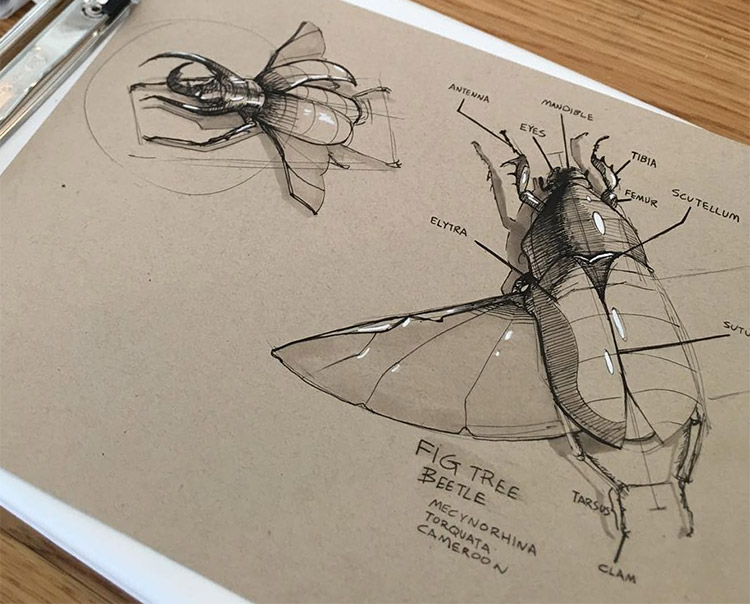
Then how do you practise this cardinal skill? I find it's all-time to start with shapes.
Everything in life tin be broken down into smaller forms like spheres, cones, cylinders, and boxes. If yous can draw these basic shapes in every perspective then yous tin can reconstruct annihilation.
If you lot want to better define your forms so follow through with cross-profile lines. This guide will get you started and show yous some swell examples.
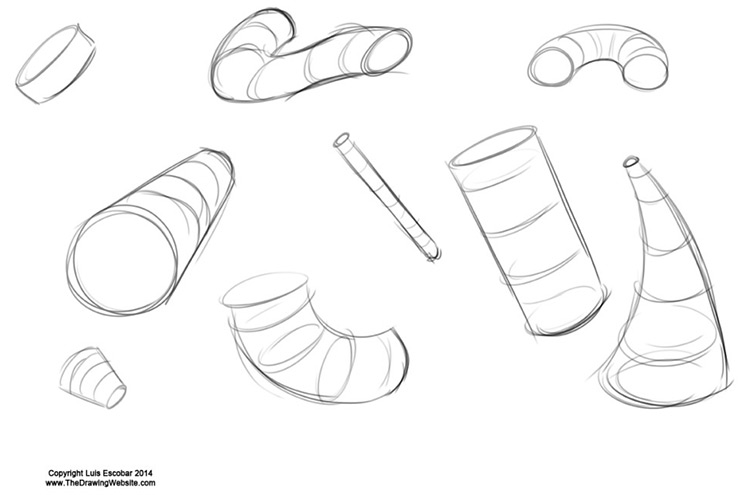
This can exist one of the easiest skills to practice simply i of the toughest to chief. You'll need to put in the piece of work and really endeavour to run across, not only copy.
When you lot start drawing from life you might endeavour the Drawabox lessons simply to practice forms consistently.
Perspective
Some other must-have skillset is the ability to draw or paint in perspective. You can find lots of great articles talking about what perspective is and how it works. But there'south only and then much free content out there to aid you larn.
However I will admit there are dozens of free perspective tutorials on YouTube if you search hard enough. This is probably the best place to start.
Seeing in perspective is knowing that as things move away from the viewer'south heart, things seem to get smaller. Terms like horizon line and vanishing point are basics and must be understood to learn perspective.
Perspective is something you merely get improve at with practice. It also connects into everything you create.
For example, the last section recommended exercises for drawing boxes and cylinders. To draw them correctly they'll need to be in perspective, whether yous understand the rules perspective or not.
Merely go on cartoon stuff and branching into new avenues. As you become curious about perspective look up some tutorials and follow forth. Some videos may recommend using a ruler while others force y'all to train your middle.
The concepts really aren't difficult to chief but they practise have time.
And the best thing about perspective is that y'all don't need to worry about tone, value, colors, or light/shading. These are necessary skills if you lot're working for a finished cartoon. But a simple perspective exercise can be washed in one single tone.
If yous want a jumpstart in your perspective piece of work there are two books you should try. The first is Perspective Made Easy, very inexpensive and a classic for new artists.
More than intermediate artists(or confident beginners) should also study from Scott Robertson's How To Draw. The volume offers real applied advice with exercises and example studies that will assist you meliorate drastically.
In that location are tons of perspective books y'all tin try and then it's good to accept a plan of how & what to study.
Simply to give you a variety of choices here are some other perspective books you might similar.
- Basic Perspective Drawing: A Visual Approach
- Perspective Made Easy: A Step-by-Stride Guide
- Perspective for Artists
Beefcake
Some may argue that beefcake is non a cardinal topic because information technology's not required for a practiced drawing. But it is a fundamental for professional piece of work, specially in entertainment fine art because it applies to any living creature that you endeavor to draw.
In one case y'all empathize how joints work y'all'll exist able to see how bones and muscles move. This applies not just to humans, just to any animal or creature with a skeleton.
But anatomy is ane of those topics you lot can study for years and nonetheless not principal. Information technology'south a cardinal concept simply very difficult to internalize. Just you have to start somewhere, then merely start slow and try to focus on one area at a fourth dimension.
If you're merely getting started with anatomy there are two resource I'd recommend.
The kickoff is Goldfinger'south Human Anatomy for Artists. This is very dry and not meant to be a 1-off learning resources. Merely information technology will prove invaluable as a reference guide considering it's so exhaustive and reliable.
Brand new artists studying beefcake volition practise great with Proko'southward anatomy video form. Information technology's cleaved into 3 different courses so you can choose to choice up the areas you lot really need to written report.
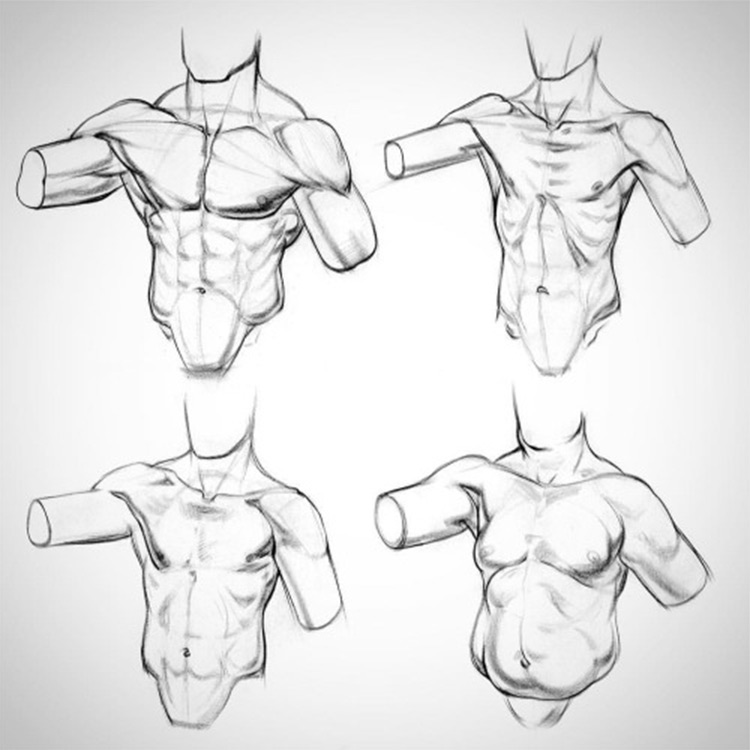
This is what I use to written report anatomy and I would never take wanted to beginning anywhere else. Stan is an amazing teacher, both with his demonstrations and his choice of words when explaining things.
I've yet to find a better anatomy serial and while there are many options out in that location, Proko'south is cheap and nifty for beginners.
Anatomy is hard. Not just considering of the technical component, simply considering of the sheer volume of data. Don't let this overwhelm you lot.
Study beefcake in bits and practice lots of studies. Get out to figure drawing sessions whenever possible. There'southward no replacement for working from a live model.
Anatomy studies will also assist you sympathise proportions and relationships between elements. This Tuts+ guide is a nice place to get started reading nigh this stuff.
Limerick
Composition is harder to teach from scratch considering it's more about the finished artwork. When all the pieces come together and form a whole you go a composition.
The overall layout of a piece is very important. Artists oftentimes consider things similar the rule of thirds or the infamous aureate ratio. Neither truly defines a composition, but they can both go into your decision making.
Your choice of composition is defined by size, angle, perspective, and attending on foreground/background objects. As y'all can tell this central skill really gets adult later in your artistic progression.
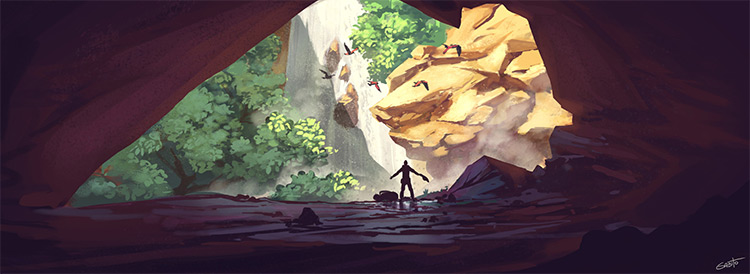
But information technology'south still something you desire to consider while practicing. It becomes much more important when you motility onto digital painting because every painting sets a scene. Y'all can find lots of composition tips but information technology's tough to really teach fundamentals of composition without actual do.
My suggestion is to study the work of other artists. Y'all'll stumble onto paintings that only stand out to y'all for whatever reason. Save these and continue them in a folder for inspiration. Check back every then often and try drawing your ain ideas with a like composition.
I'd too recommend learning a bit about composition as it relates to photography. A lot goes into crafting beautiful photos and professional photographers follow similar compositional guidelines.
The best report material is a book called Mastering Composition by Ian Roberts. It'southward a few years old but the fabric is priceless and genuinely useful to all forms of art. Plus it comes in CD/audiobook format if you'd prefer that route.
If you practice and keep pushing your compositions I guarantee everything volition start to click. This is a central skill that takes a while to build up and empathize. But once you get it you won't be able to lose information technology.
Two other books I'd recommend for artists studying composition are called Pictorial Composition by Henry Rankin Poore and one just titled Limerick by Arthur Wesley Dow.
Value & Lighting
The subject area of value is immensely detailed considering information technology covers everything related to rendering. Your knowledge of form volition prove immeasurably helpful when studying value.
If y'all're brand new to value then simply keep drawing and trying to render as best yous can. You'll observe gratuitous videos on YouTube that teach rendering, simply none will requite you everything y'all need.
I recommend doing lots of value studies especially when you lot're but starting to learn art. They can be stressful but they tin can too exist very educational.
Start out with nevertheless life drawings and progress into portraits. Stan Prokopenko has a great portrait drawing course which can help y'all exercise the fundamentals of drawing realistic faces and nailing the values.
Just drawing objects around the firm can yield fruitful results as well. Inanimate objects don't motion so you become the gamble to study from life and expand your efforts across days or weeks at a fourth dimension.
Studying value is very much the written report of light and shadow. But there is a technical side of light that you lot'll want to pay attention to if you lot're going for technical rendering.
Lighting implies shading and vice-versa. You can't accept 1 without the other.
One time y'all get into painting you'll be more concerned with colors in your lights & darks. But yous should always exist able to convey the same message through drawing with basic materials.
Shadows are cast in the absenteeism of light, so there's always a office of the object receiving more low-cal than other parts. This makes sense in theory but it's a whole different brawl game when yous put it into exercise.
Check out this Tuts+ article if you want to acquire more about lighting & shadows. Your values can be the same whether you're using color or grayscale. This is the beauty of studying value because it really helps you ameliorate your color selection later on.
Take a look at the color keys and limerick pained past Singaporean artist AC Masoen.
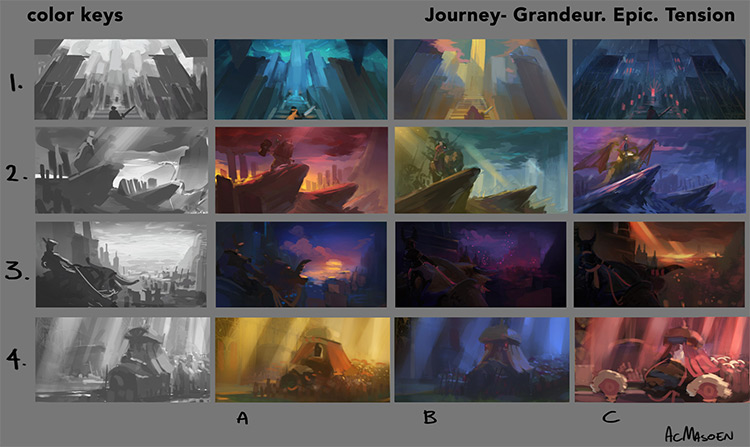
His understanding of light is expressed brilliantly in these keys. Rendering is not very tight, but expression is loftier enough quality to get the message across. This is how powerful the fundamentals of value and light tin can be.
For learning recommendations I cannot enlarge the importance of How To Render. Scott Robertson is a skilled creative person and this book should be regarded as the best guide for beginners to jump into value.
Information technology is a large volume and it covers a lot. Probably more than than a typical beginner needs to know. But this is why it's and then great because How To Render will keep teaching you for years after you lot buy information technology.
For a more technical guide I recommend Light for Visual Artists by Richard Yot. Easily 1 of the highest-rated books on this bailiwick for skilful reason.
Moving on from value is the somewhat-related simply very different field of study of color theory.
Information technology'due south way too large to break into here. But if you're prepare to motion into color then be sure you accept Color and Light by James Gurney. Undoubtedly the best book you could become for understanding how calorie-free affects colors in a painting.
The final volume I want to recommend wraps up all these fundamentals into ane big compilation. It'south called Fine art Fundamentals and was written past iii concept artists working professionally in the industry.
Information technology covers all the major fundamentals similar perspective, low-cal, anatomy, and composition.
It'south not as in-depth equally my other recommendations, only it is one of the few books focused solely on the fundamentals. Also it was written by professional concept artists so their teaching methods align perfectly with aspiring artists looking to piece of work in the manufacture.
At the end of the twenty-four hour period it doesn't really thing how y'all study or which books/courses y'all employ. All that matters is the full hours you spend practicing. And so pick whatsoever interests you the most and just get going!
If you can practice for half dozen-12 months simply on primal skills you will see noticeable improvements.
Fundamentals are crucial to every entertainment art career and they truly pave the way to your future success as an creative person.
borcherslierected.blogspot.com
Source: https://conceptartempire.com/what-are-the-fundamentals/
0 Response to "Work Orders for Animation Concept Artqhow to Write a Work Order for an Animator Concept Art"
Publicar un comentario